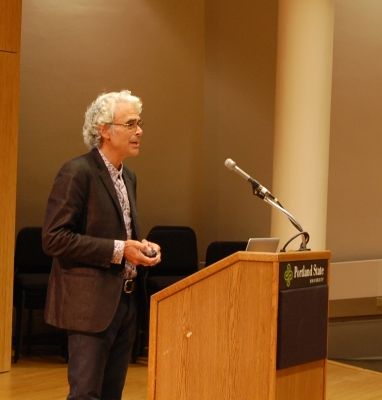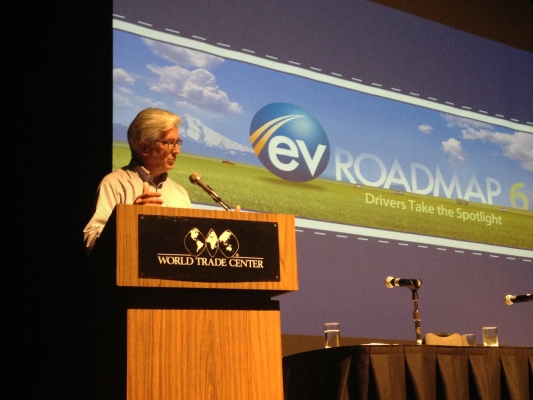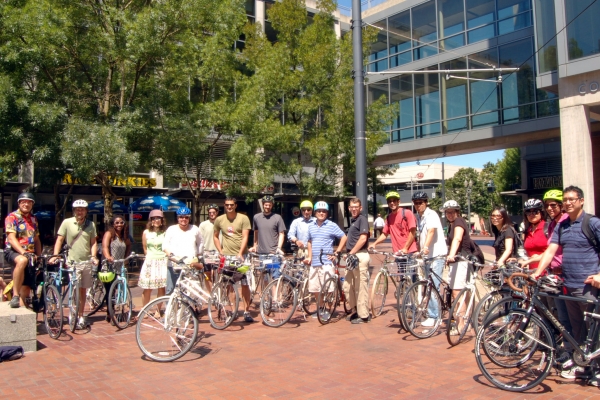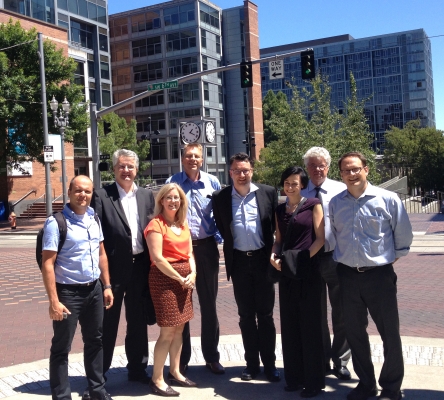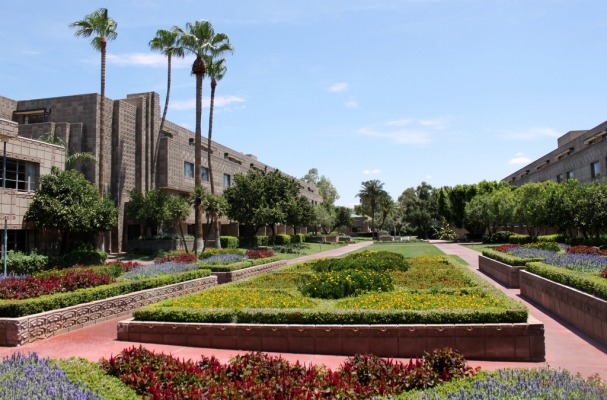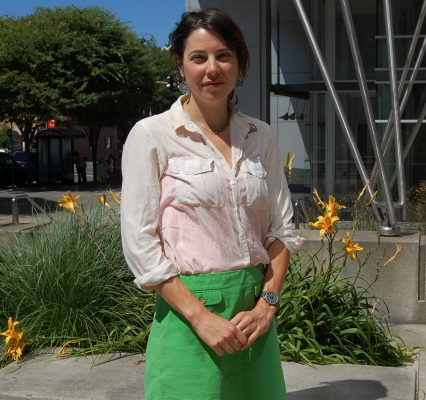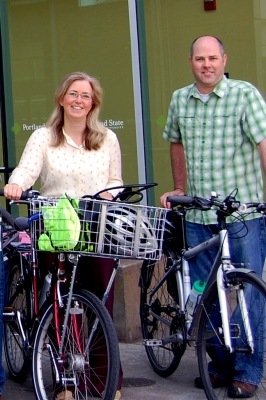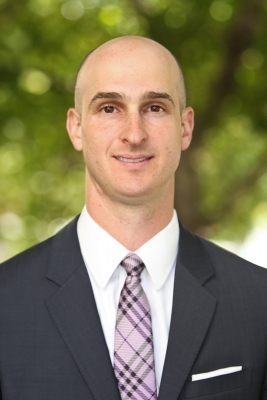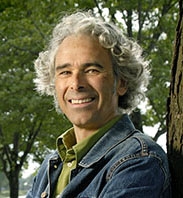(First published by BikePortland.org)
Portland has a network of neighborhood greenways, and they're great. But Jean-Francois Pronovost's is 3,100 miles long. That's approximately the distance from Portland to Nicaragua.
The Greenway (Route Verte in Pronovost's native French) is a bike route network running all over the Canadian province of Quebec. On Monday, the vice president for development and public affairs at advocacy group Vélo Québec visits Portland to share lessons from this project and others in the first annual Ann Niles Transportation Lecture, a major new series produced by Portland State University's Institute for Bicycle and Pedestrian Innovation.
The event is free, though space is limited to 240. On Thursday, BikePortland spoke with Pronovost to learn more about his life's work, the best parts of Quebec bike touring and how his hometown of Montreal managed to replace 320 auto parking spaces with a downtown protected lane that carries 9,000 bikes per day. Questions and answers were edited for space.
Can you describe your most famous achievement, the Route Verte??
The Route Verte [pronounced with hard Ts...
Read moreJohn MacArthur, OTREC’s Sustainable Transportation Program Manager, was a panel moderator at this year's EVRoadmap 6 workshop.
The EV Roadmap workshop series has established itself as the Pacific Northwest’s premier electric vehicle gathering, with a goal of increasing the visibility and understanding of electric vehicles.
Co-sponsored by Portland General Electric and Portland State University, the event supports the shared goal of building a stronger, more sustainable transportation landscape.
The sixth annual EV Roadmap workshop, "Drivers Take the Spotlight," was a continuation of this fruitful partnership. The event was held at the World Trade Center in Portland on July 30-31, 2013. MacArthur moderated a panel titled "Not All Drivers Need Four Wheels." This panel focused on odd-sized electric vehicles such as e-bikes.
E-bikes are a specialty of MacArthur's; he has conducted several research studies about people's use and perceptions of the electric-assisted bicycle. His project "Evaluation of Electric Bike Use in Portland Metro Region" (click here for more information about that project, or to download the final report) focused on exploring the potential new market segments for e-bikes and the economic, operational, safety, and...
Read moreIBPI, or the Initiative for Bicycle and Pedestrian Innovation, is a center for research and learning that is focused on bicycle and pedestrian travel.
Based at Portland State University, the group's aim is to advance bicycling and walking as integral elements of the transportation system in Oregon’s communities. July 24 -26 IBPI hosted a faculty workshop to help transportation professors integrate bicycle and pedestrian topics into their courses.
Aimed at faculty members teaching transportation courses within an accredited planning or engineering program at the university level, the workshop included curriculum, guidebooks, and field trips to gain first-hand knowledge of bicycle and pedestrian facilities in Portland, Oregon.
It was kept small, to allow for discussion and interaction. The workshop's 15 participants were first given the chance to describe the existing gaps in their courses and what they hoped to gain from the workshop, then guided through a two-day series of activities tailor-made to fit their needs.
Their goals ranged from specific to general, requesting ways to incorporate GIS analysis into bicycle and pedestrian courses, suggestions for how to integrate active travel performance measures with typical vehicular performance measures, and generally a deeper understanding of bicycle research.
Robert Bertini (Portland...
Read moreOTREC had visitors on Wednesday, July 24.
A delegation of six ECTRI directors from Austria, the Czech Republic, Germany, Norway, and Finland are finishing up a "Scanning Tour" of the United States, and OTREC was the third stop on their four-stop tour.
The European Conference of Transport Research Institutes, or ECTRI, is an international non-profit organization. Its members are 26 major transport research institutes or universities from 19 European countries, and its mission is to help build the "European Research Area" (ERA) in transport.
The 2013 Scanning Tour's theme is "Transport and Liveability: Sustainabiity of urban areas." Assisted by the Transportation Research Board, ECTRI made four stops in the USA: Washington, D.C., to participate in the TRB conference; Cambridge and Boston, Mass. for a visit to Volpe and to MIT's freight lab; Portland, Ore., to talk with Jennifer Dill and John MacArthur about OTREC's sustainable transportation program; and finally Davis, Calif., to visit the Institute of Transportation Studies at UC Davis.
Wednesday's visit was brief and pleasant. OTREC staff gave the delegation a presentation about the work that OTREC does and its sustainable cities initiative, followed by questions...
Read moreOTREC was well-represented at this year’s Western ITE conference, the 2013 conference for the Western District of the Institute of Transportation Engineers. Eight graduate student researchers presented papers at the conference, which took place July 14 through 17 in Phoenix, Arizona.
Portland State University students Katherine Bell, Kirk Paulsen, Adam Moore, Wei Feng, Sirisha Kothuri, Pamela Johnson, Sam Thompson and Alex Bigazzi attended the three-day conference and showcased their work in transportation research.
The conference was held at the Arizona Biltmore, a 1920’s luxury hotel created by architects Albert Chase McArthur and Frank Lloyd Wright. For the engineering and planning students, the Biltmore held its own attraction as an example of unique architecture, and in between events they enjoyed walking the grounds.
Katherine Bell, a Master’s student whose research interests include planning, modeling and performance measures for freight, gave a presentation on the use of a smart phone application with a GPS device for...
Read moreThe 2013 Oregon Transportation Summit will take place this fall, on September 16 at Portland State University. The summit brings together transportation professionals to shape the agenda for future research, and this year's plenary speaker addresses new federal legislation which will have a direct affect on that agenda.
Adie Tomer of the Brookings Institution will deliver the remarks at the summit's morning plenary session. The topic is MAP-21, a new act which was passed by Congress in 2012. Short for "Moving Ahead for Progress in the 21st Century," the act redistributes the scope and responsibilities of transportation departments at all levels, from municipal to federal.
"What MAP-21 essentially did is, it enhanced the evolution that's available within the federal program," Tomer said. "Because it is an overarching policy, it touches on every actor in the system in a unique way." For example, "MPOs (Metropolitan Planning Organizations) are now tasked with collecting performance measurements ... and state offices are pushed to do a little more planning when it comes to freight."
The Ann Niles Transportation Lecture series opens Aug. 26 with a lecture from Jean-François Pronovost of Vélo Québec titled "Growing a World-Class Cycling Culture: Lessons from Québec." The series is sponsored by the Ann Niles Transportation Lecture Endowment and serves as a legacy to Ann Niles, an advocate for livable neighborhoods.
Philip Niles created the endowment with a gift to the Initiative for Bicycle and Pedestrian Innovation, or IBPI, in honor of his late wife. Ann Niles was a strong advocate for livable neighborhoods and served on many transportation-related boards and committees in Portland.
The lecture series keeps alive the spirit of Ann Niles' advocacy. Niles pushed for better sidewalks and crosswalks to make Portland a safe and comfortable place to walk, and for bicycle routes and parking to do the same for bicycling.
"This inaugural Ann Niles Transportation Lecture, and all those that follow, help spread Ann's passion for creating livable neighborhoods to students, practitioners and the greater community," said OTREC Director Jennifer Dill.
The series' first speaker, Pronovost, has helped bring active transportation into the lives of people in communities across Québec. As vice president for development and public affairs for Vélo Québec, he helps develop new projects and partnerships.
One of the...
Read more
